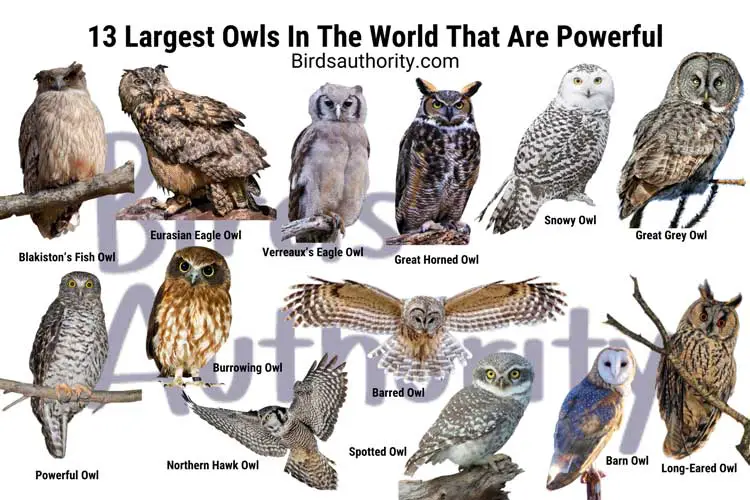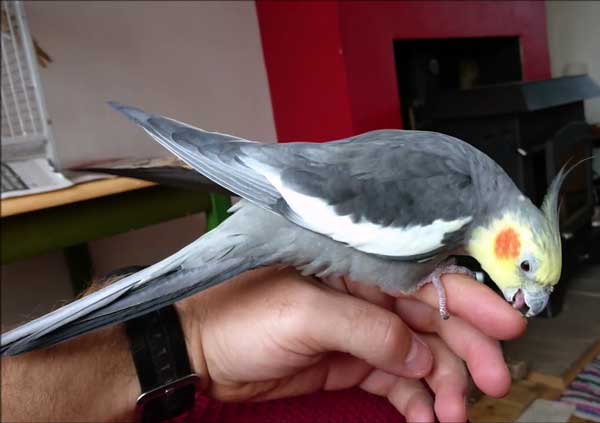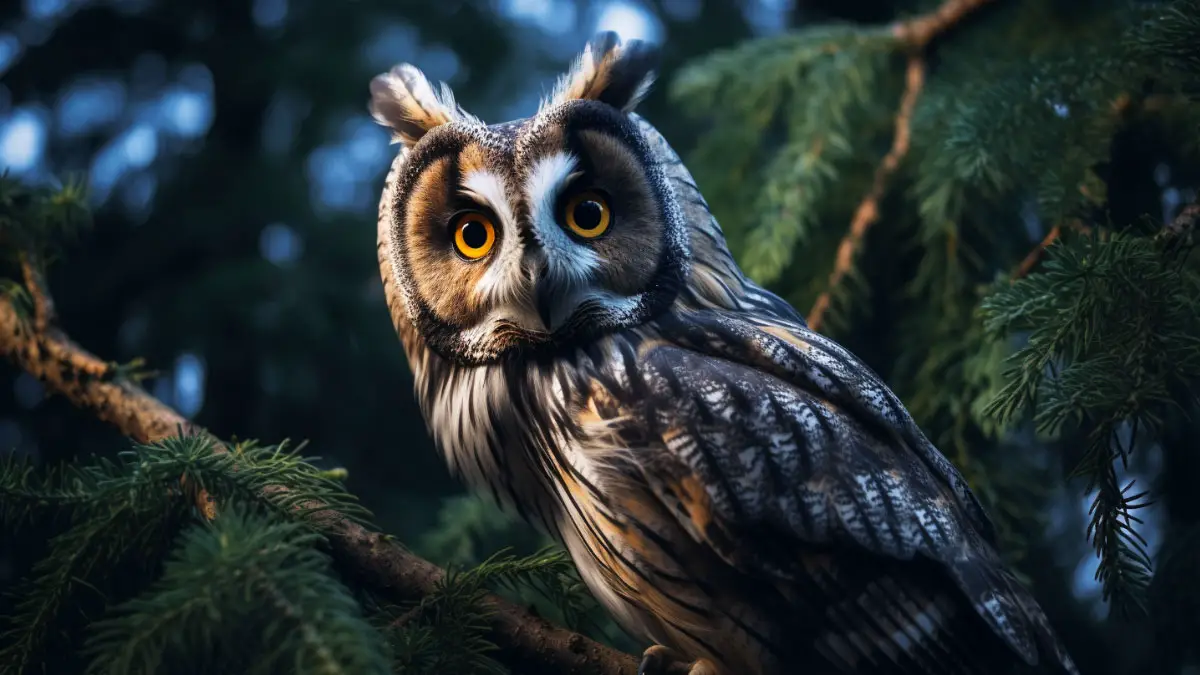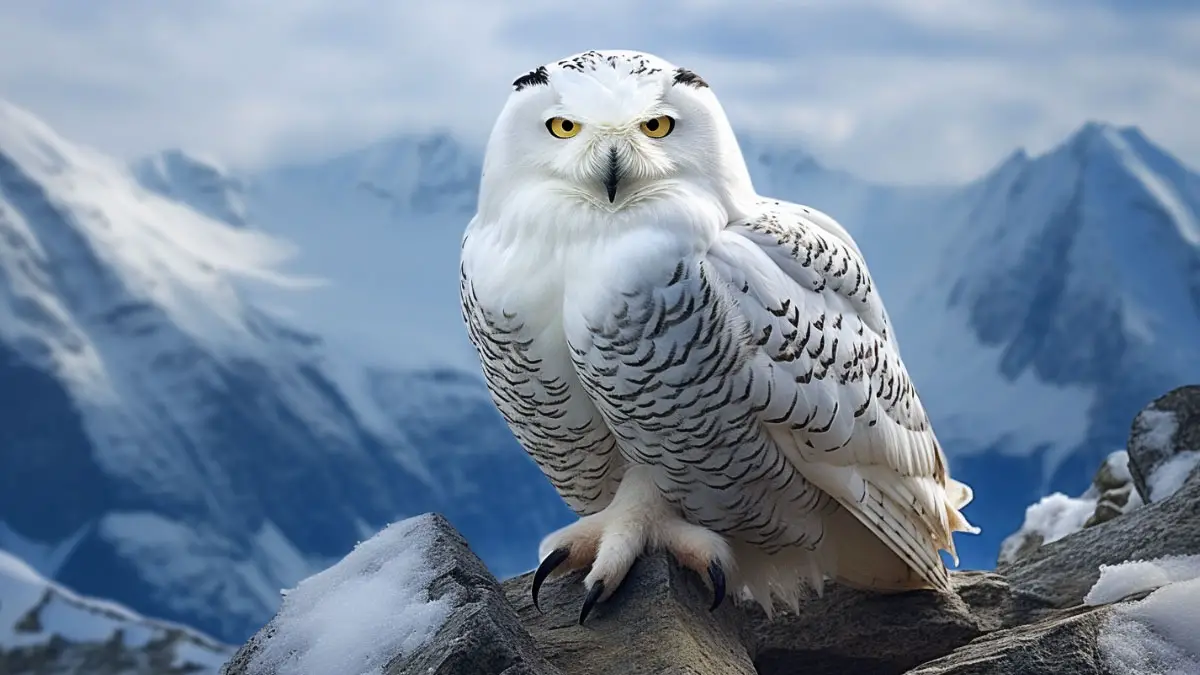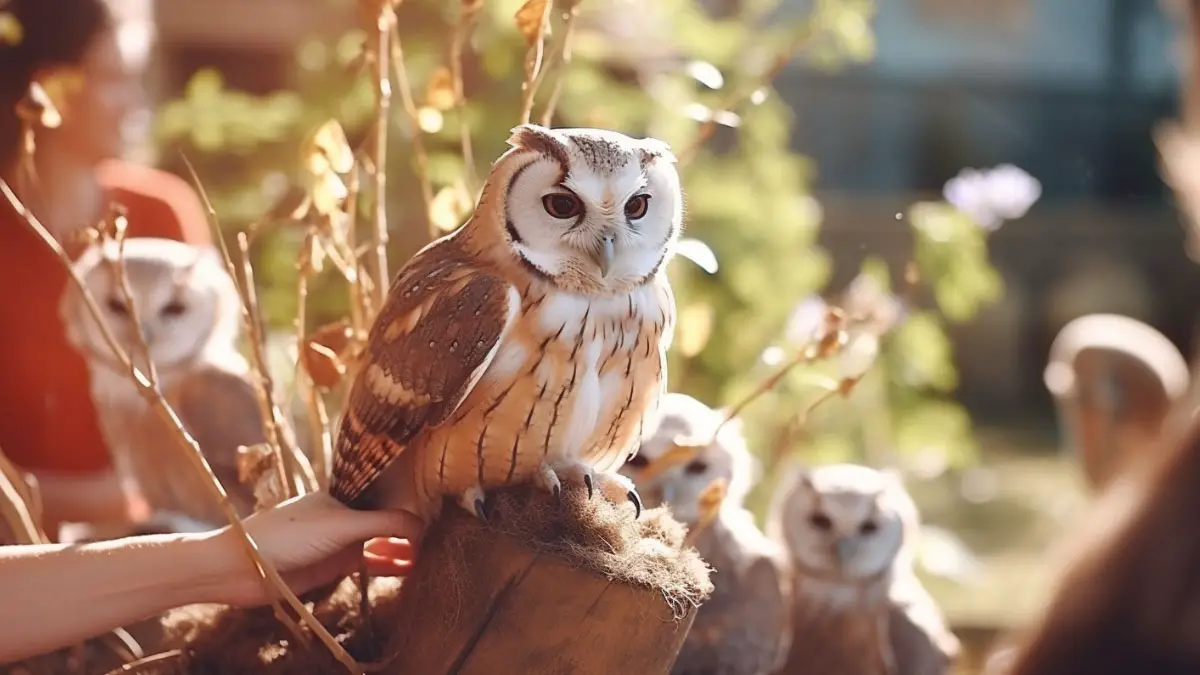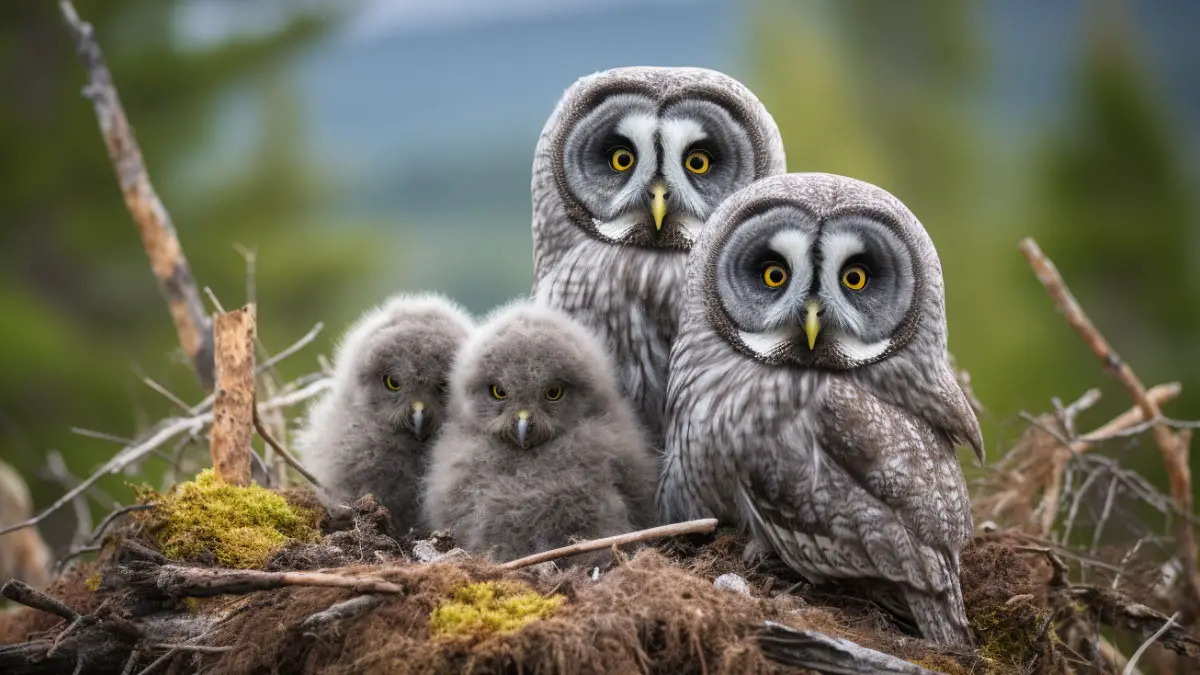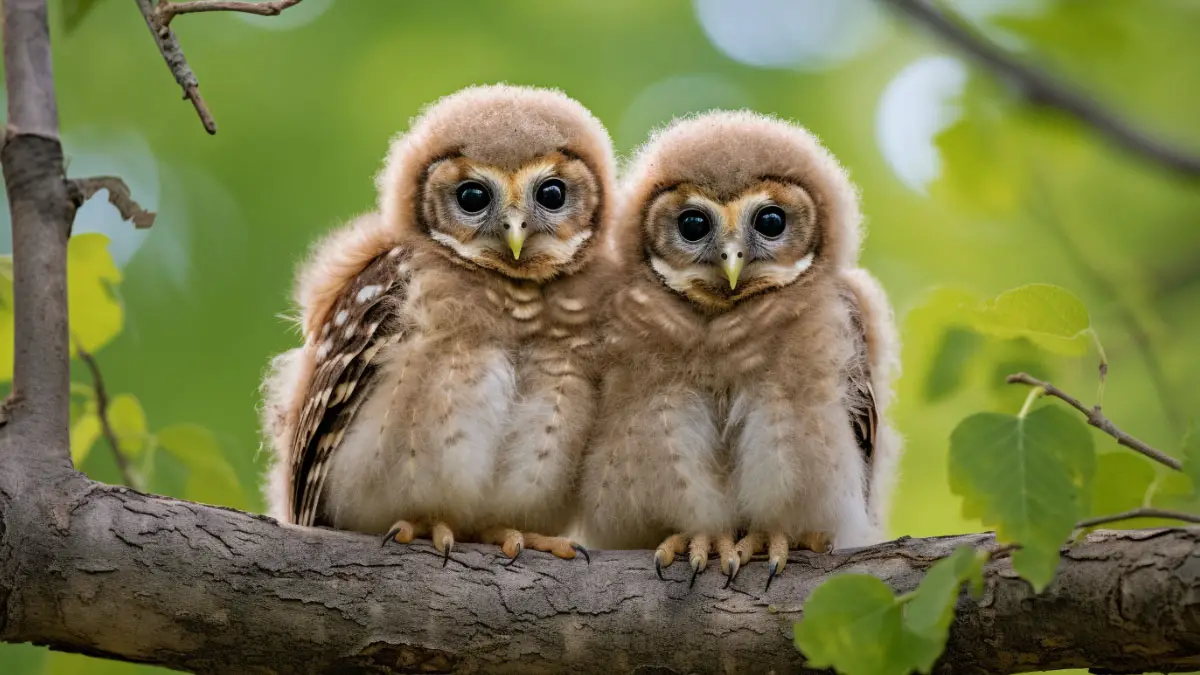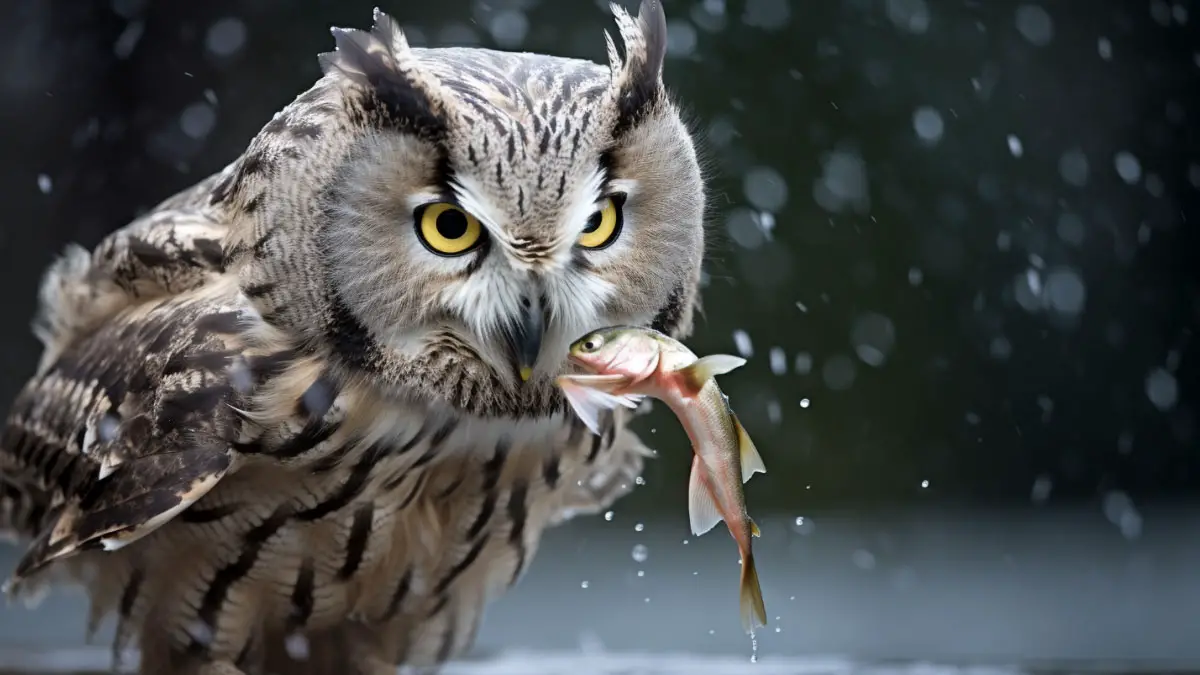There are around 250 owl species found all over the world. Some are large, powerful owl species, and some are tiny, fragile creatures.
So what are the 13 largest owls in the world that are powerful? Blakiston’s fish owl, Eurasian eagle owl, great grey owl, snowy owl, etc. are the world’s most powerful owls in the world. All these 13 owls are not only powerful, but they are on the bigger side. The 3rd one on the list is the owl species with the most extended bodies.
In this article, we have mentioned all about them in detail. Keep reading to learn about the 13 largest owl species and where they reside worldwide.
How Big Is An Owl?
An owl’s size can be similar to a hawk. As hawks are active during the day and owls are active at night, they are considered counterparts. Their length ranges from 5-33 inches (13-84 cm), and their wingspans are 1-6.6 feet (0.3-2.0 meters).
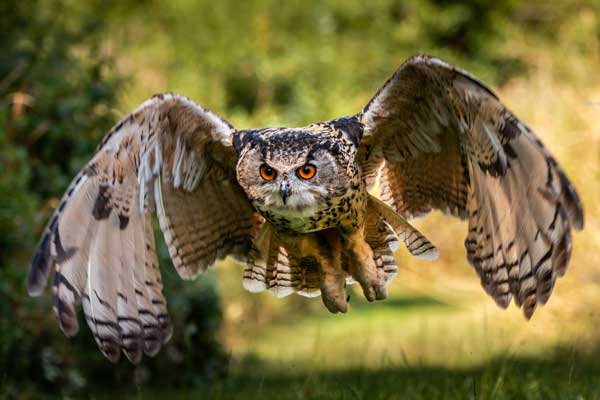
Most of the owl species are on the smaller side, and only a handful are on the larger side.
13 Largest and Biggest Owl In the World
There are around 250 species of owls all around the world. Among them, most species are not big owls, and only a handful have a formidable size. Below, 13 of the largest and biggest owls have been mentioned alongside their habitat.
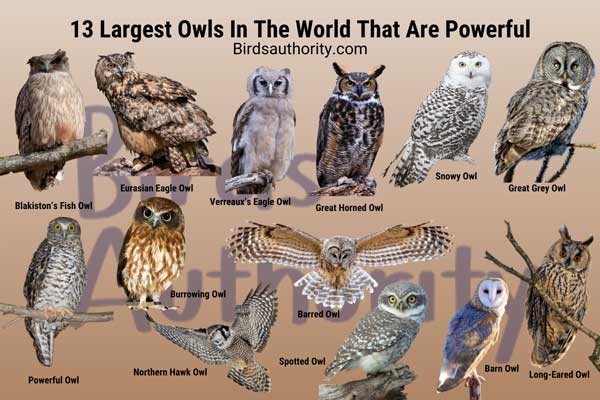
1. Blakiston’s Fish Owl
- Wingspan: 178–200 cm
- Weight: 6.4-10.1 pounds
The world’s largest owl also the biggest species was named after a British naturalist. His name was Thomas Blakiston, and he documented the bird in 1883 for the first time. Even though its wingspan is the biggest, there are another large owl species that is a tall owl species in comparison.
Its length from the beak to its tail can be as long as 72 cm, and its wingspan can be up to 200 cm, the largest owl wingspan. It also weighs more than all other owl species, weighing as much as 10.1 pounds.
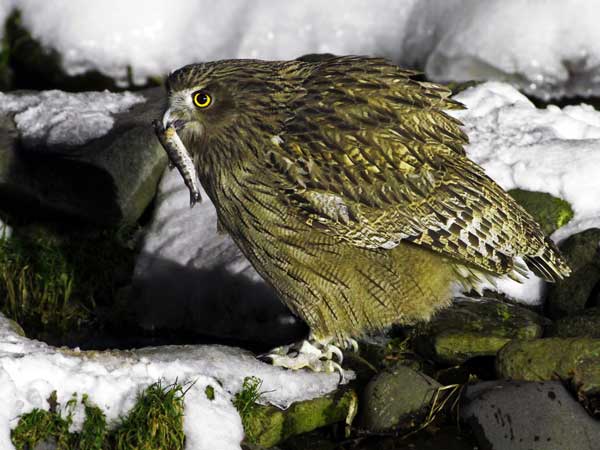
Habitat
They are usually found on Hokkaido, a Japanese island in the Far East. They can also be seen at the Kuril and Sakhalin islands of Russia and Vladivostok, A Russian city. The Manchurian region of China is also a habitat for Blakiston fish owls.
Recently the bird has been said to be facing extinction due to the demolition of their natural habitat due to urbanization. Only 150 Blakiston’s Fish Owls are estimated to reside in Japan only. The biggest population of Blakiston’s Fish owl is currently seen in Russia.
It is estimated that 1,500 birds are in Russia. Geneticists are worried about the hereditary diseases among the Blakiston’s Fish owl species. As they have only a tiny population, it can result in their inbreeding. That is why they are susceptible to hereditary diseases.
2. Eurasian Eagle Owl
- Wingspan: 131–188 cm
- Weight: 2.6-10.1 pounds
The 2nd largest Owl in the world is the Eurasian Eagle Owl. It can grow to have a body as long as 75 cm as a tall owl species. They are longer than Blakiston’s Fish Owl, but they are not the tallest Owl. But they have smaller wingspan than the Blakiston’s Fish Owl, and they can be as long as 188 cm.
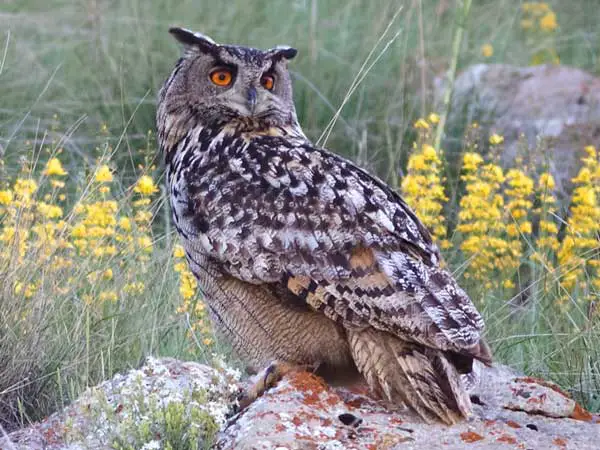
Habitat
Their habitat is around Asia. But they avoid the tropical region in the South and Southeast of Asia. They can not endure the cold well. So they avoid Northern Europe and Siberia as well. But they live around Southern Europe.
The Eurasian Eagle Owl has a wide habitat range so that it can populate and grow. Scientists estimate that one million Eurasian Eagle owls can be found worldwide. So it is not endangered of extinction like Blakiston’s Fish Owl.
3. Great Grey Owl
- Wingspan: 140–152 cm
- Weight: 1.3-4.2 pounds
You may have heard of the “Phantom of the North.” It is the nickname of the Great Grey Owl. Its gray plumage makes an excellent camouflage for hunting prey. The Great Grey Owl is the tallest Owl, and as the tallest Owl, it has 84 cm in length from its beak to its tail.
But its wingspan can only be up to 152 cm. It is a big owl, but the previous was a huge Owl as a species.
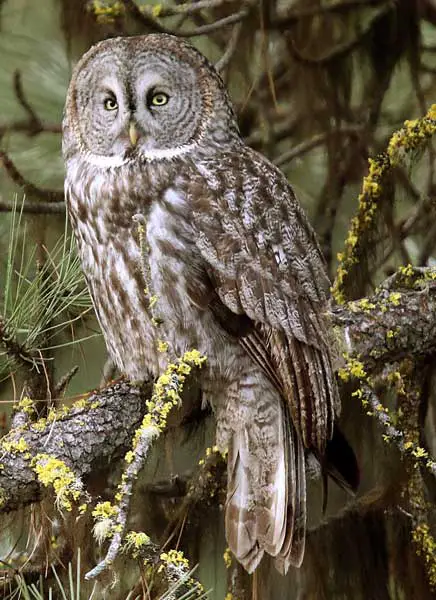
Habitat
The species Great Grey Owl used to reside in Northern Asia before it migrated to North America. Now, it can be sighted in Canada and Russia. They can also be seen in the northwestern states of the USA, albeit the population is small there.
Although urbanization has impacted the species, its population is still thriving well. So it is not endangered or in threat of extinction.
4. Snowy Owl
- Wingspan: 125–150 cm
- Weight: 3.5-6.6 pounds
Snowy Owl is an iconic species of Owl. If you are a fan of harry potter, you know Harry’s pet owl was a snowy owl. Although its white plumage contains hints of black speck on its wing, its beauty is unparalleled. They are also a large owl species which compliments their beauty.
71 cm is the tallest, and their wingspan can be around 183 cm. In the case of Snowy Owls, the biggest threat to them is not human development but rather their tendency to crash into vehicles and airplanes.
There are records of them getting severe injuries from crashing into planes and vehicles. Their population had a huge drop and has an estimation of 100,000 birds alive, which makes them an endangered owl species.

Habitat
The white plumage helps this snowy owl to blend into the snowy Arctic environment effortlessly. That is why it has another name, the Arctic Owl. But you shouldn’t think that the Snowy Owl only remains in the snowy areas. For hunting and nesting, they fly to the sub-arctic regions as well.
5. Verreaux’s Eagle Owl
- Wingspan: 140–164 cm
- Weight: 3.3-7 pounds
Verreaux’s Eagle Owl has many different names. Some call it the Giant Eagle Owl, and some call it the Milky Eagle Owl. It is the largest owl species in Africa and the tropical region.
Jules Verreaux, a french naturalist who first documented this species, is the inspiration whose name was used to name the owl species. It was first documented in the early 19th century. Its length can be up to 66 cm long, and they have a wingspan of up to 164 cm.
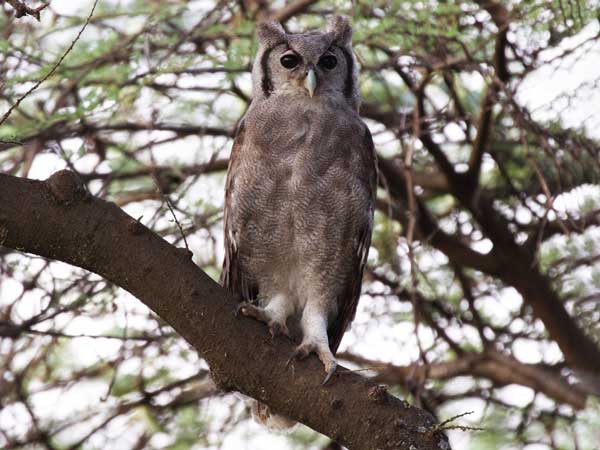
Habitat
Its habitat is in the south of the Sahara, across the African continent. This kept the species from expanding north. Verreaux’s Eagle Owl species have also adapted to human development. They changed their feeding patterns and thrived.
Although their population is not known currently, they are not endangered.
6. Great Horned Owl
- Wingspan: 91–153 cm
- Weight: 2.6–3.5 pounds
Great Horned Owl is the biggest Owl in Texas and the most commonly found species in America. It’s named as such because of its horn, like a feather on its head. Their appearance is like a horn, but they are just feathers.
Other than attracting mates, the purpose of their horns is still a mystery. The Great Horned Owl species can be as tall as 64 cm and can have a wingspan of 153 cm. They are one of the big owl species.
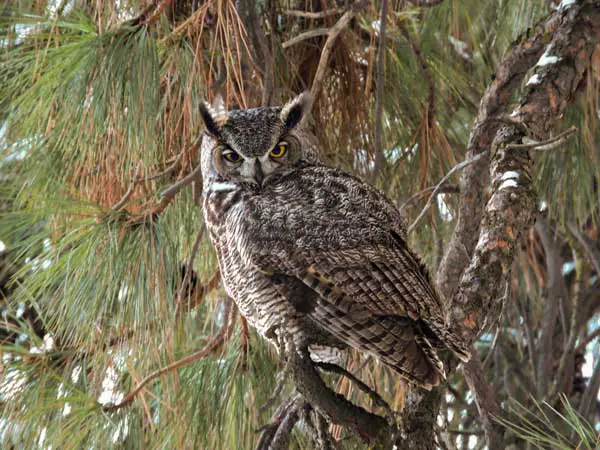
Habitat
Their habitat is across the North American continent. But they can also be seen in Central America and the northern regions of South America. A small population of this species can be seen in places like Brazil and the eastern part of Argentina.
Their vast habitat has allowed them to keep a stable population and grow.
7. Barred Owl
- Wingspan: 96–125 cm
- Weight: 1-2.53 pounds
Barred owls, also known as Striped Owls, have striping patterns all over their body. They are the only owl species with brown eyes in the Eastern part of the USA.
In contrast, all the other owl species have golden or yellow eyes in that region. Their length can be up to 63 cm, and they can have a wingspan of 125 cm.
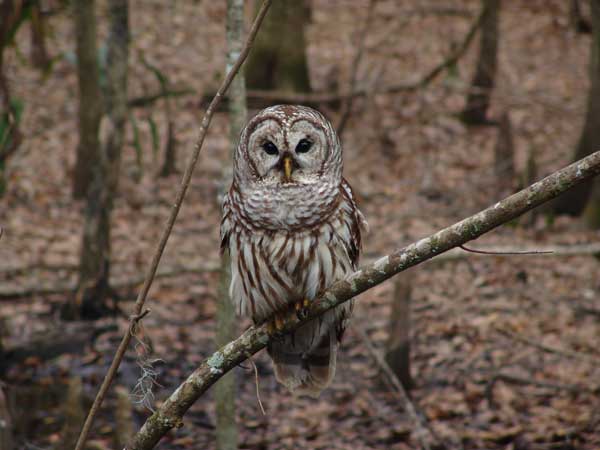
Habitat
Other than the eastern part of the USA, Southern Canada has a large population of Barred Owls. They are considered to be invasive species and the most successful owl species.
They are better predators compared to other ones in their neighboring areas. Scientists even considered culling their species to keep the Barred Owls population in check.
8. Powerful Owl
- Wingspan: 112–135 cm
- Weight: 2.2-4.4 pounds
The Powerful Owl, also called the Powerful BooBook, is the biggest species of Owl in Australia. They are considered one of the apex predators of the continent. They can be as long as 65 cm and have a wingspan of up to 135 cm.
The Powerful Owl species are considered the most carnivorous owl species. This is the only species that can match up to them, as 75% of their diet is meat.
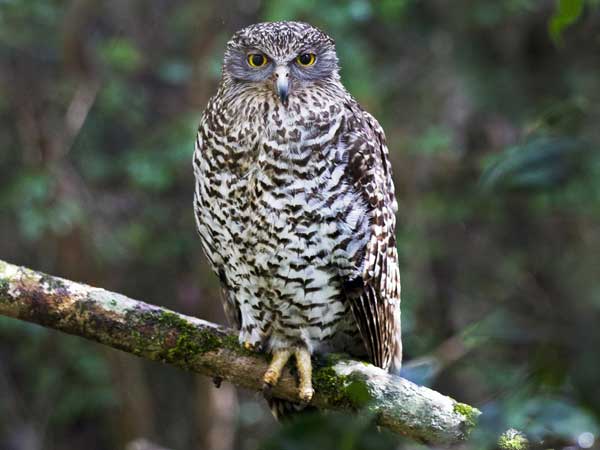
Habitat
Their natural habitat is on the Eastern coast of Australia and the Great Dividing Range mountains. The mountains are an obstacle to the species expanding to other continents.
Although it’s unclear if they are endangered, Victoria and New South Wales states say it to be vulnerable, but international organizations say otherwise.
9. Spotted Owl
- Wingspan: 114 cm
- Weight: 1-1.3 pounds
When you first see a spotted owl, you may be mistaken to think it is a Barred Owl. They have similar appearances, and although subtle, they have differences. The Spotted Owls have cross-shaped spots, whereas the Barred Owls have stripes.
There is also competition between the Spotted and Barred Owls, which causes a negative impact on the Spotted Owls. Unlike the Barred Owls, international organizations consider them an endangered species. The Spotted Owls can be as long as 43 cm and can have a 114 cm wingspan.
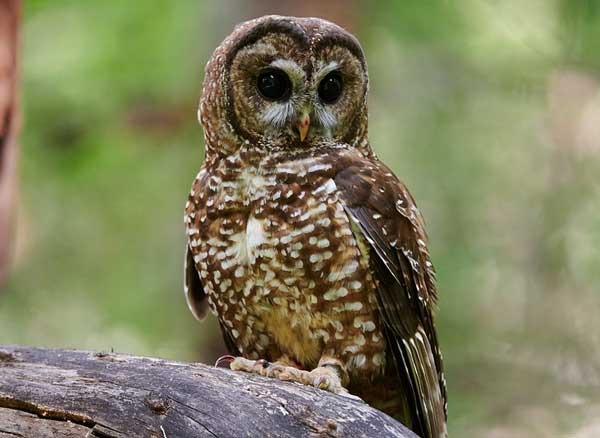
Habitat
Their habitat is in Mexico, and some of the population is scattered around the Western and Southern USA. Due to the demolition of their natural habitat, the Spotted Owls suffered.
10. Long-Eared Owl
- Wingspan: 86–102 cm
- Weight: 0.35-1 pound
Long-Eared Owl or Lesser Horned Owl is similar to the Great Horned Owl, as they also have horn-like feathers. They can be 40 cm long and have a wingspan of up to 102 cm.
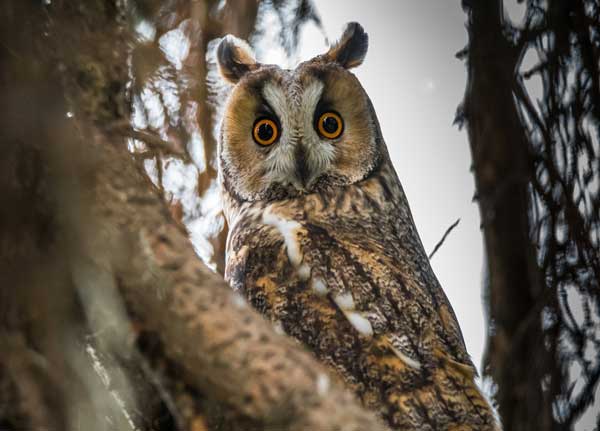
Habitat
They reside in a lot of places. Much of Asia and Europe are their natural habitat, and the USA also falls under their natural habitat. They have the most presence in Southern Canada and Mexico. But they avoid the cold Siberian regions and Southern and Southeast Asia.
As they have a decreasing trend in their population, scientists are concerned for them, and human development is the primary cause of their endangerment.
11. Northern Hawk Owl
- Wingspan: 45 cm
- Weight: 0.6 pounds
- Length: 44.7
The Northern Hawk Owl species resemble the spotted or barred owl species and have spots. Their length can be 44.7 cm, and they can have a wingspan of 45 cm. They are not so much of a tall owl species in comparison. Thus, this owl weight is less compared to other species.
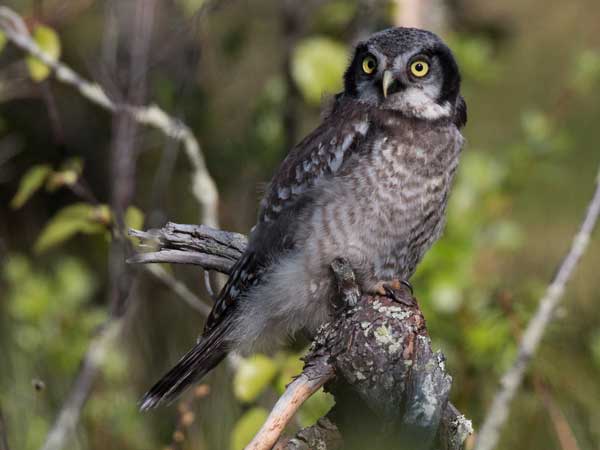
Habitat
Their natural habitat is in Northern Minnesota and other Northern and Central states of the USA. They also have a population in the Southern parts of Great Britain, Scandinavia, and Southern Russia.
Their population does not have a decreasing trend, and thus, scientists have not declared them to be an endangered species.
12. Barn Owl
- Wingspan: 80–95 cm
- Weight: 0.16-1.36 pounds
Barn Owl species are a widely spread species, and they can be found in most places worldwide. They can be up to 39 cm long and have an 80-95 cm wingspan. Although they are on the smaller side among the large owl species, they are significant among the 250 species.
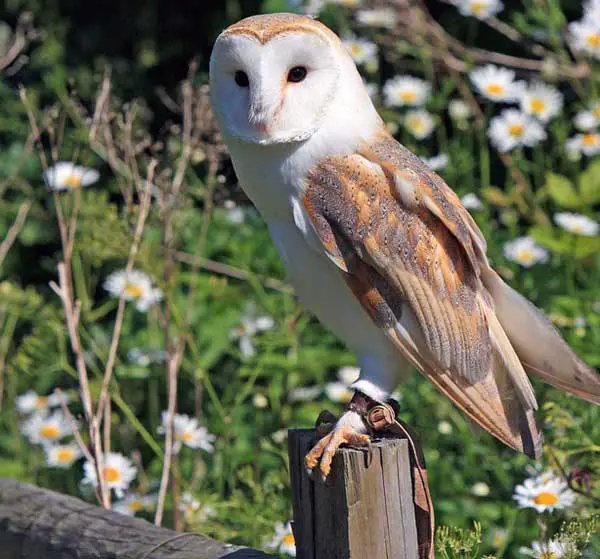
Habitat
Their habitats are in Vancouver and Ontario in Canada, Africa, the Canary Islands, etc. Among the Canary islands, Lanzarote and Tenerife have a better population of the Barn Owl species.
Due to the loss of grasslands, their population is suffering and having a decrease in their population. Road mortality is also a part of their decrease. In Canada and USA, there has been a decrease in their population. That makes them an endangered species.
13. Burrowing Owl
- Wingspan: 86–102 cm
- Weight: 50.8-61 pounds
Burrowing Owl, also known as Shoco, is an owl with long legs, and they can be as long as 28 cm and have a wingspan of 86-102 cm. They are not substantial owl species compared to the others mentioned previously, but they are among the big ones.

Habitat
This owl species can be seen in various states of the South USA, Mexico, North America, and a few places in Central America. They can also be seen in a few places in Canada’s Caribbean Islands, and Subtropical and temperate regions are their most preferable habitat.
In some areas of Southern Brazil, some of their population are distributed. Accordingly, as they have been seen less than their previous population, they are considered endangered owl species.
What Is The Biggest Owl In The World?
The world’s largest Owl is the Blakiston’s Fish Owl species. They are a huge owl species with a wingspan growing up to 200cm. In comparison, only the Great Grey Owls are bigger as they are the longest owl species.
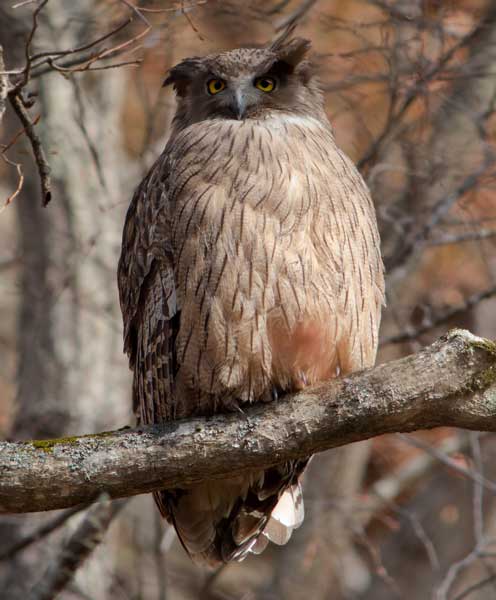
FAQs
Here are some common inquiries related to the owls you may have.
Elf owls are considered the smallest owls. Their height is less than 6 inches, and they can weigh nearly an ounce and a half. Even a golf ball is slightly heavier than an elf owl.
Yes. Based on predatory abilities, great horned owls are fierce and can hunt large prey, such as Peregrine Falcons, Ospreys, Prairie Falcon, and raptors. They also hunt smaller prey like scorpions, rodents, frogs, etc. Their talons can force up to 28 pounds when clenched.
No. Owls can not be larger than an eagle. Although owls are considered “the tigers of the air,” bald eagles are much larger than owls. The wingspan of bald eagles is 83 inches on average, and they can weigh up to 10 pounds.
On the other hand, great horned owls’ wingspan is half of that and stands at 48 inches. Their weight can be 3.7 pounds.
Conclusion
The 13 largest owls in the world that are powerful are full of variety and beauty. Some are taller than others and few of the species are wider than others. Likewise, some have cross spots and some have no spots. Snowy Owl, who has a snowy white body, is also an example of beauty.
You have learned about the owl weight, length, habitat, and wingspan of every owl species. Now you know all about them and maybe even found the one you like and want to get as a pet.
